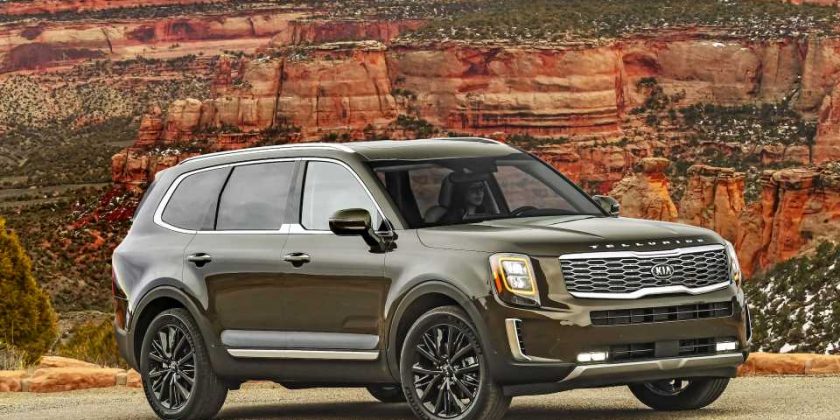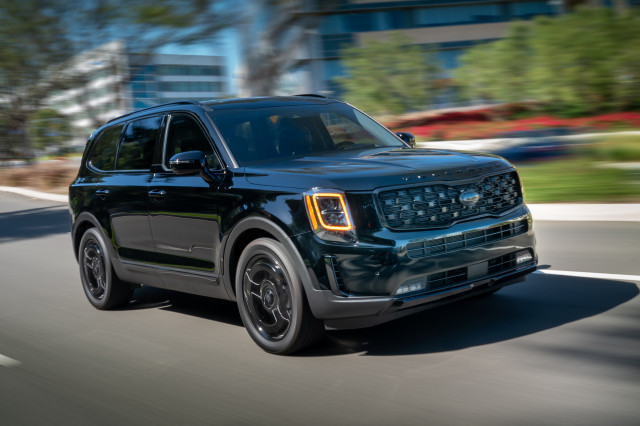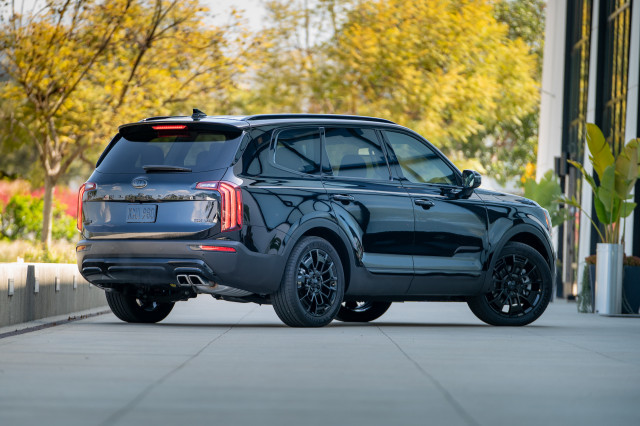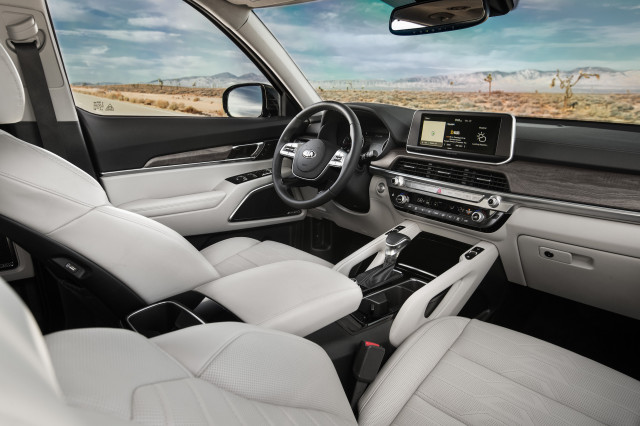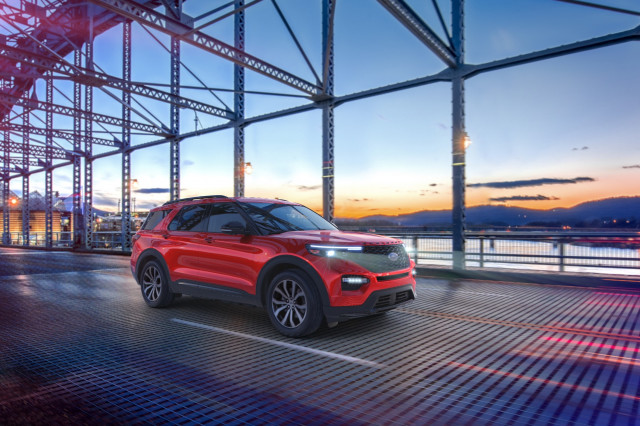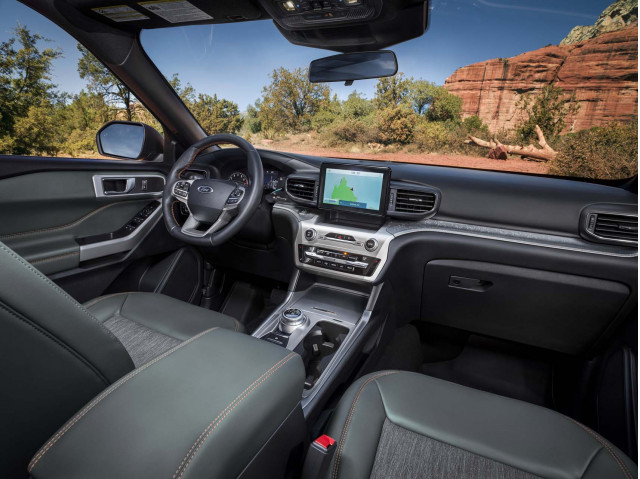The three-row family crossover is the next best thing to the minivan without the soccer mom stigma. Several automakers do a good job of providing space and utility in their three-row crossovers, Ford and Kia among them. The 2021 Ford Explorer and 2021 Kia Telluride take a different approach to the family hauler, but which one is better for you and your family?
Our numbers give away the game right from the top. The Telluride scores a TCC Rating of 7.5 out of 10, while the Explorer gets a 7.0. But the numbers don’t tell the whole story and despite its lower score, the Explorer will appeal to some buyers for its strengths.
Both models are attractive, but the Telluride comes off as a scaled down, but sleeker, GMC Yukon, with a squared off body that looks both macho and elegant. The narrow headlights and wide grille contribute to the appealing hefty stance, even though it’s not backed by any particular ruggedness.
The Explorer’s body has more of a rake that lends it the look of a sporty wagon more than a macho SUV. The body is leaner than the last generation, with angled C-pillars that contribute to the sporty vibe. It looks better the more you notice the body’s complex shapes.
2021 Kia Telluride
2021 Kia Telluride
2021 Kia Telluride
The Telluride’s interior is more attractive. It’s both carlike and boxy, with a low-set dash and a large touchscreen. It comes off as upscale in most models. The Explorer also has a car-like interior and a large touchscreen, but it just doesn’t feel as luxurious as the Telluride.
Performance is the Explorer’s main strength. With the natural handling advantage of a rear-wheel-drive platform, the Explorer offers a smooth ride and buttoned-down moves, though it lacks some road feel.
The Explorer also has more engine options, including a twin-turbo V-6 that makes up to 400 hp in ST models. The other engine choices are a 2.3-liter turbo-4 with 300 hp and a 3.3-liter V-6 hybrid with 318 hp. The twin-turbo V-6 has raw power, but we also appreciate the power of the base engine.
The Telluride takes a softer approach and comes with just one engine, a 290-hp 3.8-liter V-6 that serves its purpose well. On the road, the Telluride leans into turns more than the Explorer, and feels more isolated from the road, which is great for ride quality but bad for control and engagement. Both models offer the all-weather security of all-wheel drive without a focus on off-road prowess.
Both vehicles offer lots of room for passengers and their cargo, but the Telluride can seat up to eight rather than seven in the Explorer, and it has materials that push into luxury territory. We’re most impressed by the Telluride SX model with its wood and chrome trim and available nappa leather upholstery and synthetic suede headliner. Those materials would look right at home in a BMW or Mercedes.
Interior space is almost exactly the same despite the extra seat in the third-row of the Telluride. The Explorer has 18.2 cubic feet of cargo space behind the third row, 47.9 cubic feet behind the second row, and 87.9 cubic feet with the second- and third-rows folded. The Telluride can haul 21 cubic feet of cargo behind the third row, 46 cubic feet behind the second row, and 87.0 cubic feet with both rows folded down. The Explorer’s second-row seats are bulkier to move, and both vehicles offer comfortable front seats, though the base seats in the Telluride don’t have power adjustments.
2021 Ford Explorer Timberline
2021 Ford Explorer Enthusiast ST
2021 Ford Explorer Timberline
Safety is a strength for both vehicles. Automatic emergency braking, active lane control, and blind-spot monitors are standard for both, but the Telluride also comes with adaptive cruise control.
Both score well in crash testing. The Explorer earns a Top Safety Pick+ award from the IIHS and a five-star overall rating from the NHTSA, though it has a four-star rating for rollover protection, which is common among high-riding crossovers and SUVs. The Telluride gets a Top Safety Pick award from the IIHS, one step down from the Explorer, and a five-star rating from the NHTSA, though it has four-star ratings for rollover and frontal crash protection.
The Telluride distinguishes itself in the features category. Both come with healthy standard feature sets and both have good infotainment systems with at least 8.0-inch touchscreens, but we rate the Telluride higher due to its excellent warranty and greater overall value. Power features, three rows of seats, and Apple CarPlay and Android Auto come standard on both family haulers for prices in the $34,000 range. The Telluride’s value is at the top of the lineup, however. Starting at $43,360, the SX model feels like a gateway to the luxury market, and it’s hard to get a Telluride to $50,000. The Explorer, on the other hand, can top $60,000, and the hybrid starts above $50,000. It’s easier for Telluride buyers to get the equipment they want at a reasonable price.
We give both vehicles the same rating for fuel economy, though the Explorer is more efficient in its base form and it offers a hybrid. With all-wheel drive and the 2.3-liter turbo-4, the Explorer is rated at 20 mpg city, 27 highway, and 23 combined. With its 3.8-liter V-6, the all-wheel drive Telluride is rated at 19/24/21 mpg. The Explorer hybrid is rated at 23/26/25 mpg with all-wheel drive, and the ST model’s 18/24/20 mpg rating is almost as efficient as the Telluride, despite being much more powerful.
The numbers show the Telluride is the winner here. It’s more comfortable, better looking, a better value, and feels more upscale. However, the Explorer presents a compelling choice. It scores better in crash tests, handles better, offers more power, and comes in a more efficient hybrid model.
Summary
Styling
Performance
Comfort & Quality
Safety
Features
Fuel Economy
MSRP
Invoice
Fuel Economy – Combined City and Highway
Engine
Drivetrain
Source: Read Full Article
